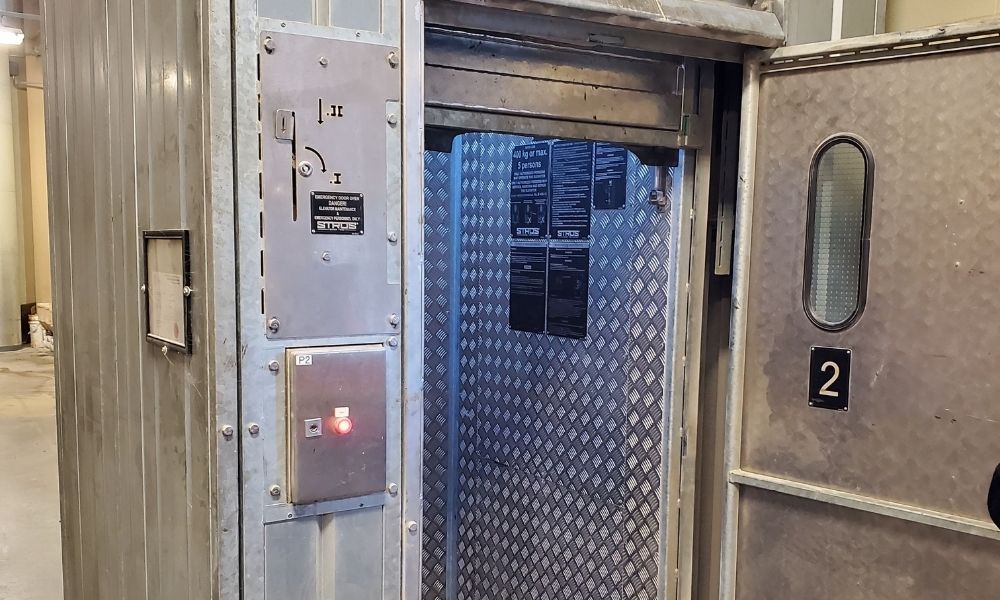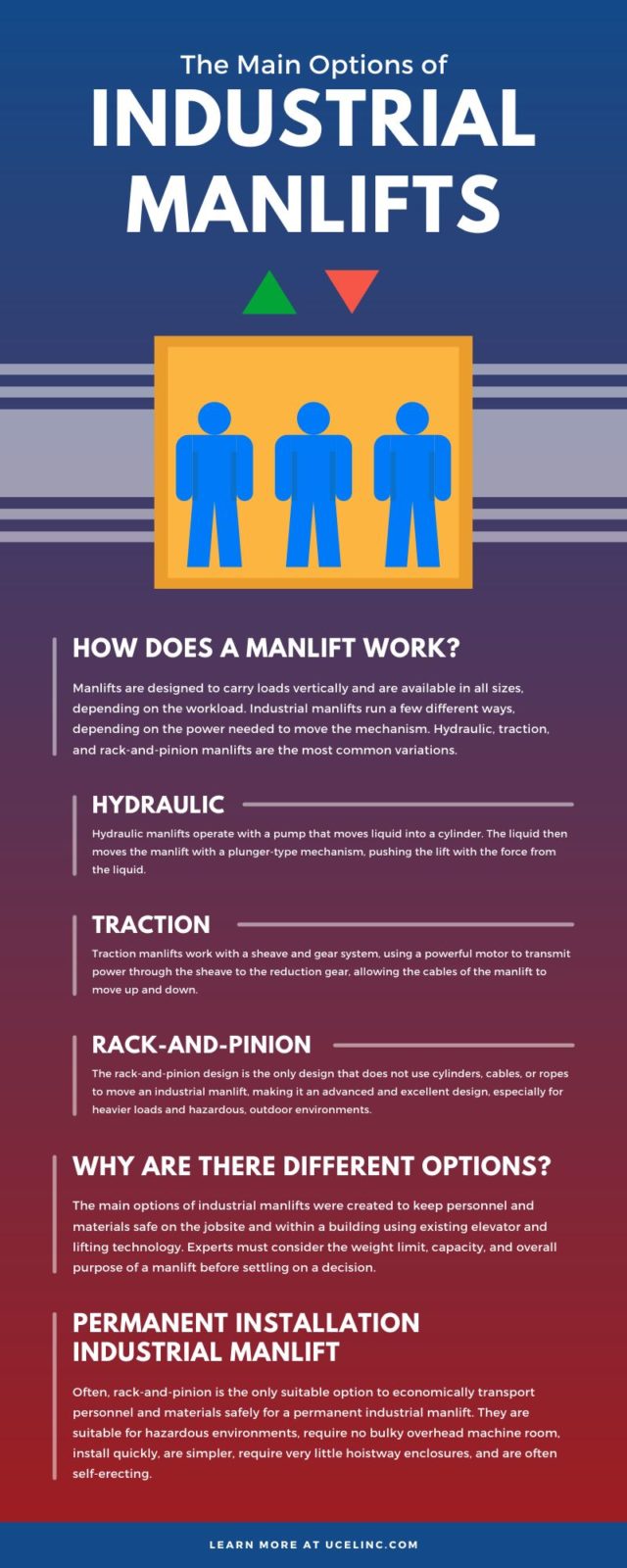As the word indicates, an industrial manlift is used for transporting personnel, sometimes along with materials, on a jobsite, and is not to be confused with freight elevators, which are designed to carry freight only. They vary greatly in power, but all serve the same purpose—to get people and materials where they need to go. When choosing a manlift for your operations, it is necessary to understand the main options of industrial manlifts.
How Does a Manlift Work?
Manlifts are designed to carry loads vertically and are available in all sizes, depending on the workload.
Industrial manlifts run a few different ways, depending on the power needed to move the mechanism. Hydraulic, traction, and rack-and-pinion manlifts are the most common variations. Our manlifts use rack-and-pinion drive systems.
Hydraulic
Hydraulic manlifts operate with a pump that moves liquid into a cylinder. The liquid then moves the manlift with a plunger-type mechanism, pushing the lift with the force from the liquid.
Traction
Traction manlifts work with a sheave and gear system, using a powerful motor to transmit power through the sheave to the reduction gear, allowing the cables of the manlift to move up and down.
Rack-and-Pinion
The rack-and-pinion design is the only design that does not use cylinders, cables, or ropes to move an industrial manlift, making it an advanced and excellent design, especially for heavier loads and hazardous, outdoor environments. These types of lifts can be designed for personnel only and can be used to transport a combination of personnel and materials on the jobsite.
The rack-and-pinion design uses a motor attached to the top of the elevator car, and the drive gear (which is the pinion) is then attached to the motor. The design is quicker to install than others and runs on its own without the need for a separate operating area, making it the most efficient.
Why Are There Different Options?
The main options of industrial manlifts were created to keep personnel and materials safe on the jobsite and within a building using existing elevator and lifting technology. Experts must consider the weight limit, capacity, and overall purpose of a manlift before settling on a decision.
Lifts are used in construction, demolition, warehouses, silos, bridgework, mining, and anywhere else that an efficient lift system is needed.
Understanding what each lift can do makes choosing the right option easier and more reliable.
Permanent Installation Industrial Manlift
Often, rack-and-pinion is the only suitable option to economically transport personnel and materials safely for a permanent industrial manlift. They are suitable for hazardous environments, require no bulky overhead machine room, install quickly, are simpler, require very little hoistway enclosures, and are often self-erecting.
Normally, service is provided turnkey from equipment provision through inspection and ongoing maintenance for the entire lifespan of the machine.
Temporary Construction Site Installation Industrial Manlift
Temporary installation serves construction sites well, as the lift is no longer needed after the construction job is complete. This includes industrial project in all sectors. Rack-and-pinion construction lifts and temporary man and material construction hoists are perfect for the application because they can be installed quickly, are extremely safe, and can be removed with almost no building impact.
Service is also usually provided turnkey, sometimes in coordination with on-site personnel to assist, from installation to removal.
Industrial Manlift Rentals
Although uncommon, renting a manlift is also an option especially on a site where there are space constraints but the project needs vertical lifting. A common application is in the boring of large holes for infrastructure work.
Lift Cars and Cages
An industrial manlift consists of one or more cars and can be enclosed with solid doors or a cage. The environment in which the lift will run and the required needs it must meet will determine which method is best.
Industrial Manlift Materials
The best manlifts are a rack-and-pinion design that is built using strengthened steel or aluminum parts for optimal strength, safety, and reliability.
Safety When Using Any Industrial Manlift
The best way to use industrial manlifts safely is to follow all safety guidelines. These standards will vary depending on the job and the lift. Lifts can be customized with all sorts of safety features and training can be provided in person, virtually, or a train-the-trainer program can be implemented.
Regardless of the lift or job in question, however, all personnel on the job should be trained on the subject and adhere to safety standards when operating or working around industrial manlifts. The manlift installation company may offer their own training courses.
Manlifts may also be built with extra safety features, which employees will need to be aware of as well.
Emergency Lowering Mechanism
The emergency lowering mechanism is used when a loss of power occurs and the lift needs to be lowered safely to the ground. It is best to be prepared for this scenario rather than to experience unexpected power loss and have an emergency on your hands. It should be noted that most emergency lowering systems cannot be used in the case that a safety device has tripped, so a rescue procedure should be in place too.
Emergency Brake System
An emergency brake system can be installed to ensure swift braking in an emergency. Although brakes are made to last, especially in a rack-and-pinion design, anything can happen on a jobsite due to unforeseen disasters.
Telephones, firefighting services, and many other options are available to keep personnel safe in an industrial manlift.
Maintain Your Industrial Manlift
A well-maintained industrial manlift leads to fewer safety issues. Keep a few things in mind for maintaining a safe lift for an efficient and safe jobsite or building.
Doors
If you are using a lift that is enclosed with doors, you should inspect them daily before beginning any job. A lift of this type is no good without useable doors. If personnel or materials get stuck on the lift or if they cannot even get on in the first place, you will lose time and money. Schedule daily door checks to avoid this issue.
Sticking Buttons
Before the day’s activities begin, examine the emergency buttons to make sure they are in working order and are not sticking. Do not allow anyone to operate the lift if there is any problem.
Daily Manlift Test
A regularly scheduled test run of the industrial manlift is your best bet to ensure a safe and productive day of using the lift. Taking preventative steps is well worth your time, as doing so will allow you to avoid hazardous conditions, making the site safe and productive.
You can schedule onsite safety check-ups and tests to ensure a consistently smooth manlift and jobsite. Drop tests, maintenance service contracts, technical support, and manlift repairs should be offered through the company that installs the site’s industrial manlift.
When Repairs Are Needed
Sometimes, a manlift will require repairs, whether they are large or small. A good industrial manlift company will offer their services to you at such times. You should never try to handle the repairs yourself, as doing so is likely illegal and could create a larger maintenance issue, injuries, and significant liability. Allow the manlift company to do the repairs for the jobsite.
Most often, they will only need to replace a part and, if the lift was installed correctly in the first place, they will not need to do too extensive of repairs. As with any machine, a manlift’s parts will eventually wear out; this should be expected and detailed by your service provider.
UCEL, Inc. can answer all your questions about industrial manlifts and how to make them safe. We lead the industry in rack-and-pinion industrial manlifts.

